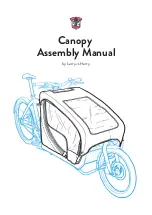
24"
24"
5 1/2"
HITCH
BALL
BUMPER
5 1/2"
HITCH ASSEMBLY WITH BUILT-IN SWAY
CONTROL BALL MOUNTING PLATFORM -
BALL MOUNTING BAR (4) NOT REQUIRED
1 3/8" FORWARD OF
HITCH BALL
1 3/8" FORWARD OF
HITCH BALL
TRAILER TONGUE
1. INSTALLATION
Refer to figures 1 and 2
WELD BALL MOUNTING BAR (4) FLUSH
WITH TOP OF HITCH BALL MOUNT
(NOTCH IF NECESSARY)
GENERAL SWAY CONTROL MOUNTING DIMENSIONS
a. Connect trailer to tow vehicle. Position vehicle and trailer in a straight line on a level surface.
b. Mount sway control ball (1a) using nut (1b) and lock washer (1c) to hitch as shown in Figure 2 and torque to 100 lb-ft. If necessary
notch and weld ball mounting bar (4) into position shown.
c. Measure and mark a point on the trailer tongue 24" from the center of the hitch ball as shown in Figure 2.
d. Align the center of the ball of the ball/plate assembly (3) with the mark on the trailer tongue and center punch four hole locations. Drill
four holes using an 11/32 ( 343) drill bit for 1/8" ( 125) or thicker trailer tongue material or a 9/32" ( 281) drill bit for thinner material
four holes using an 11/32 (.343) drill bit for 1/8 (.125) or thicker trailer tongue material, or a 9/32 (.281) drill bit for thinner material.
e. Position the ball/plate assembly (3) over the drilled holes and drive four of the self tapping screws (2a) through the plate and into the
trailer tongue. Drill the two remaining holes and install the screws.
2. HOOK-UP
a. Lubricate both balls with a small amount of grease, place socket of slide bar (6) over ball (1) and secure with clip (2b). Loosen handle
(5) until the slide bar can be moved. Extend sway control assembly and place socket over ball on trailer, secure with other clip (2b).
b. Retighten handle until it stops (handle should be in its original level position). The sway control assembly is preset at the factory with a
g
p (
g
p
)
y
y
p
y
tension suitable for most light trailers.
c. On some installations, damage to the sway control may occur during extremely sharp turning maneuvers. This can be checked by
slowly backing vehicle into a jackknife position while someone is watching. Do not allow slide bar to contract completely (bottom out)
or bumper to contact sway control. If it looks as though contact will be made or the sway control will bottom out then the sway control
must be removed before backing trailer.
3. ADJUSTMENT
a. Trailer configurations and loading, road and weather conditions, towing speed, tire condition and pressure, and center of gravity of
t il
ll ff
t t
i
T
t
i
b
fit f
th
t l
bl
i
f
d t
t
h
ld b t k
ith th
trailer, all affect towing. To get maximum benefits from the sway control assembly, a series of road tests should be taken with the
loaded trailer. During the first road test try the sway control at the factory pre-set force. On subsequent trips increase or decrease
tension by turning the adjusting bolt (7) in 1/4 turn increments in the direction shown on the label until the desired control is achieved.
For large trailers, it may be necessary to install a second sway control unit.
b. After about 1000 miles of towing, remove the slide bar from the sway control and clean the friction surfaces with a wire brush. Repeat
this cleaning procedure about every 10,000 miles.
4. UNHOOKING
a Release tension by turning on/off handle counterclockwise
For Installation Assistance or Technical Help, Call 1-800-758-0869
26660IN-0196C © 1996 REESE PRODUCTS, INC. Litho
in
USA
a. Release tension by turning on/off handle counterclockwise.
b. Remove both clips (2b), remove sway control.




















